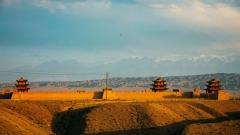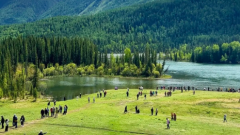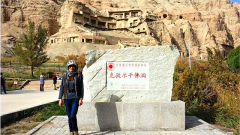Hidden high in the Pamir Mountains of far western Xinjiang lies Tashkurgan, one of China’s most remote and fascinating towns. Often called the “Roof of the World,” this border settlement is home to the Tajik ethnic minority, whose unique culture, language, and architecture set them apart from the rest of China. For travelers seeking untouched landscapes, ancient Silk Road history, and authentic cultural encounters, Tashkurgan offers an unforgettable experience.
Where Is Tashkurgan?
Tashkurgan sits at an altitude of about 3,200 meters (10,500 ft), surrounded by the snowcapped peaks of the Pamir Plateau — one of the highest and most majestic mountain regions on Earth. It’s located near China’s borders with Pakistan, Afghanistan, and Tajikistan, serving as the last major town before the Khunjerab Pass, which connects China and Pakistan via the Karakoram Highway.

Tashkurgan
Despite its isolation, Tashkurgan has long been an important stop on the ancient Silk Road, linking traders and travelers from Central Asia to China for over a thousand years.
The Tajik People: A Culture Above the Clouds
Tashkurgan is primarily inhabited by the Tajiks of China, a small but proud community known for their hospitality, traditional stone houses, and mountain lifestyle. Unlike the Turkic Uygurs or Han Chinese, the Tajiks here are of Iranian origin and speak a language related to Persian, though many now also speak Uyghur or Chinese.
Cultural Highlights:
-
Dress: Tajik women often wear bright-colored dresses, embroidered hats, and silver jewelry that glitters under the mountain sun.
-
Music and Dance: Their music is rhythmic and soulful, often accompanied by traditional string instruments. During festivals, men and women perform circle dances that celebrate joy and togetherness.
-
Hospitality: Visitors are warmly welcomed with tea, yogurt, and homemade bread — simple but heartfelt gestures that reflect their open nature.
The Tajiks’ high-altitude life is one of balance — between nature, family, and faith — shaped by centuries of survival in the mountains.
The Ancient Stone City of Tashkurgan
The Tashkurgan Stone City (石头城) is the town’s most iconic landmark and a must-visit for anyone traveling along the Karakoram Highway. Perched on a hill overlooking the river valley, the ruins date back over 2,000 years and were once a key fortification on the Silk Road.

Tashkurgan Stone City
From the top, you can enjoy sweeping views of the Golden Grassland and the distant Muztagh Ata and Kongur peaks — two of the tallest mountains in the Pamirs.
Walking through the remnants of crumbling walls and towers, it’s easy to imagine camel caravans resting here after long journeys between China and Central Asia.
The Golden Grassland and Pamir Views
At the foot of the Stone City lies the Golden Grassland, a vast meadow that glows in sunlight, surrounded by snow mountains and dotted with grazing yaks and sheep. During summer, wildflowers bloom, turning the valley into a painter’s dream.
Tashkurgan’s scenery changes dramatically with the seasons — golden in autumn, white and silent in winter, and lush in spring and summer. For photographers, the combination of blue sky, white peaks, and golden plains makes it one of the most photogenic regions in western China.
The Khunjerab Pass: Gateway to Pakistan
Just 125 kilometers south of Tashkurgan lies the Khunjerab Pass (4,693 m), the world’s highest paved border crossing. It marks the boundary between China and Pakistan and serves as the most dramatic section of the Karakoram Highway.
Visitors can drive up to the pass (weather permitting) to see the monumental border gate, surrounded by snow even in summer. The journey itself is breathtaking, with winding roads, glacial valleys, and the occasional herd of yaks crossing the highway.
Note: The pass is typically open from May to October and requires a border permit for travelers visiting independently.
Experiencing Local Life
The best way to experience Tashkurgan is to slow down and connect with the locals. Spend a night in a Tajik-style guesthouse, try their homemade yogurt, or join a local market day when families from surrounding villages gather to trade goods.
You can also visit village schools, where children often welcome visitors with songs, or mountain pastures, where herders share stories of life among the clouds.
This kind of cultural immersion gives travelers a deeper appreciation of how humans adapt to life at such extreme altitudes.
Getting to Tashkurgan
Tashkurgan is remote, but reaching it is an adventure in itself:
-
From Kashgar: Most travelers start from Kashgar, about 300 km away, and drive along the Karakoram Highway (G314). The trip takes 6–8 hours, with stops at scenic spots like Karakul Lake and Muztagh Ata.
-
New Airport: The Tashkurgan Airport, opened in 2022, now offers limited flights to Urumqi and Kashgar, significantly reducing travel time.
-
Best Time to Visit: May to October offers clear skies, mild temperatures, and accessible mountain passes. Winter travel is possible but extremely cold, and some roads may close due to snow.
Travel Tips for Tashkurgan
-
Altitude: At over 3,000 meters, altitude sickness can occur. Ascend gradually and rest if needed.
-
Permits: Foreign travelers need a border permit to visit Tashkurgan and the Khunjerab Pass. Your travel agency, such as China Dragon Travel, can help arrange it.
-
Accommodation: Comfortable guesthouses and new hotels are available, though facilities are simpler than in major cities.
-
Local Etiquette: Ask permission before photographing locals. Dress modestly, and show respect for local customs and religion.
-
Connectivity: Mobile signal and internet can be limited in some mountain areas — a good opportunity to disconnect and enjoy nature.
Conclusion
Tashkurgan is not just a border town — it’s a living museum of Silk Road history, mountain culture, and human endurance. Here, among stone ruins and golden meadows, the Tajik people continue their timeless way of life, offering a glimpse into a world few travelers ever see.
Whether you’re drawn by its landscapes, its people, or the adventure of the Karakoram Highway, Tashkurgan rewards you with a sense of peace that only the high mountains can offer.
Plan your journey with China Dragon Travel to explore this remote gem on the edge of China and experience the warmth of Tajik hospitality firsthand.






![11 Day Tour[Winter Limited] Drunken Beauty Xinjiang Ice and Snow Kanas Fairy Tale New Vision](https://www.chinadragontravel.com/wp-content/uploads/2025/12/25cff76cef9e445-240x135.jpg)





